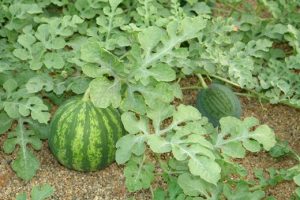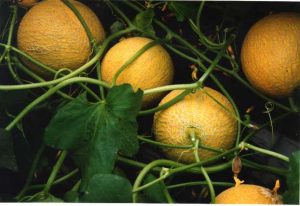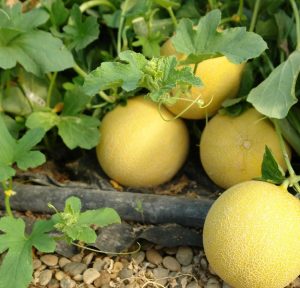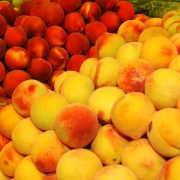Uneven trend in marketing melon and watermelon
By Milagros Jurado
The latest marketing trend show an uneven two seasonal products such as watermelon and cantaloupe, bending the balance clearly in favor of the former, which has been gaining ground on the second, both surface-production and value- prices. In fact, watermelon consolidates more and more as a product of clear export orientation, with 75% of its production for the foreign market, compared with 51% who holds melon, according to data provided by the Association of Producers Organisations fruits and Vegetables of Almería (COEXPHAL).
The areas most affected by this decline in melon are those whose production is mainly directed towards exports, as is the case of Andalusia and Murcia. In fact, since COEXPHAL it points to the massive presence in the European market for Moroccan melon, but also overseas (Brazil and Costa Rica), as the main cause of this downward trend in the surface-production and price-value product. Thus, the average price of melon in 2015 fell by 3.2% (0.61 € / kg) compared to the previous year (0.63 € / kg), according to Customs data. In contrast, the average price of watermelon during 2015 increased by 9.8% over the previous year (0.41 € / kg), reaching 0.45 euros per kilo.
Test of the clear export orientation of watermelon sector that is, by volume, the third most exported fruit Spain. Its acreage in our country is 17.900 hectares (centered mostly in Andalusia (50%), Valencia (18%) and Murcia (12%)), representing a total production of 869.000 tonnes of which 654.586 tonnes they were allocated in 2015, mainly European, with a value of 299.1 million euros foreign markets.
The figures of Spanish exports of watermelon in last year representing an increase of 17.3% in volume and 27.6% in value and outperform melon, whose total production (856.951 tons) were exported last year 434.700 tons, also mainly to countries in Europe, worth about 269 million euros. Data representing a growth of 7.6% in volume and 5.1% in value.
The main destination of Spanish exports of watermelon is Germany, which absorbs 280.000tn, representing 43% of total exports. Behind are France, with 109.000tn, and the Netherlands, with 50.000tn. These amounts represent a customs value of 125, 51 and 20 million euros respectively. They are followed by importance in volume and value, UK, with 46.740tn and 19100000; 30.152tn and Portugal with 7.5 million and Sweden with 21.831tn and 10.5 million.
The total volume of melon exported by Spain in 2015, the main target was France, with 109,208 tons and 78.2 million; followed by Germany with 102,893 tons and nearly 59 million; UK, with 61,527 tons and 34.3 million; Netherlands with 55,809 tons and 30.3 million and Portugal, with 36,019 tons and 18.8 million.
Regarding the export figures of melon and watermelon to non-EU markets, the fact is that they are insignificant compared to the European market, although they are beginning to address new markets such as US, UAE and Singapore, among others, is becoming very timid and barely perceptibly.
Interprofessional Melon CLM
Castilla la Mancha is the producing area of Spain that more acreage concentrated melon (mainly in the variety of toad skin), with 34% of the total acreage (26,700 hectares). Next in importance Andalusia (24%) and Extremadura (6%). In the case of this region, we have a still very fragmented sector, which orients its production more towards the domestic market.
For, among other purposes, organize the production sector of melon, foster good relations with business houses, which are making significant advances in virus research, and promote campaigns to stimulate consumption, was faced the constitution of the Interprofessional Melon in Castilla la Mancha. An organization, which is still pending publication of its recognition as an association and that currently is working on drafting its standard extension.
Explains the president of the Interprofessional and president of the Market Melon and Watermelon Castilla la Mancha, Cristóbal Jiménez, last season, were planted in this region 12,000 hectares between melon and watermelon, and production of melon, 300.000tn watermelon, 250.000tn. “Last year was balanced supply with demand, selling more kilos of melon, which, however, was not reflected in the price as did happen in the case of watermelon.” We can say it was an atypical campaign melon “, he noted.
He also noted that this year the melon surface is slightly lower than surface facing the watermelon. “Specifically, some 500 hectares less, although both crops are evenly matched, they are very limited by the availability of water.”
Jimenez also referred to the decrease in volume and hectares of melon production in cooperatives. “In Castilla La Mancha we have three cooperatives and one Agricultural Transformation Society (SAT) whose collective output of melon could represent 20% and that ultimately would be around 10%.” These figures are confirmed from Agrifood Cooperatives Castilla la Mancha, organization according to which in 2015 the production of melon cooperatives in this region was 24.000tn (10.6% of total production, 225,000 tons) and watermelon 15.000tn (14.7% of CLM, 102.000tn). These figures contrast with cases like the Almeria province, where we find that both crops are highly cooperativized, as production cooperatives melon and watermelon is around 70% of total sales.
One of the most significant projects on which he has informed the president of the Interprofessional Melon Manchego community refers to the work being carried out in collaboration with the Administration and with virologists and geneticists commercial houses to homogenize a characteristic melon Castilla la Mancha. “We intend to obtain a distinctive genetic enters so many varieties of toad skin to give a melon genetic homogeneity that goes well in this growing area,” he said.
The promotion also is emerging as one of the priorities of this Organization, since there has been a decline in domestic consumption of melon in the last five years. “We must say that watermelon, a product that relies heavily on the vagaries of the market, exported more than melon toad skin,” he clarified.
Innovation and R & D as a business strategy
One of the constants of both crops is the commitment to research and innovation to adapt their offer to the tastes and demands of an increasingly segmented market, consisting of very many-colored public with habits very different consumption and in which the traditional family model has given way to another family units that meet new needs (portions or smaller sizes, etc). In this regard, note that a current trend is the consumption of mini watermelon, a variety that today represents 11%.
Thus, in melon, is currently pursued small size gauges, between 800 and 1,200 grams, and the continuous improvement of texture, flavor and sugar. It also seeks to innovate in the presentation, such as yellow and orange flesh melons, maintaining a small caliber.
Other lines of R & D are oriented to traditional varieties, like the classic Piel de Sapo (produced mainly in Castilla la Mancha), reduce its size without affecting its quality as always.
Currently, the most traded varieties, in the case of melon are Gaul and Yellow, which constitute 35%, the Cantalupo (15%) and Piel de Sapo (10%). The remaining production is an amalgam of varieties. In the case of watermelon, highlight how, in recent years, have been imposed on the market seedless varieties. One type of watermelon, launched in 1992 by the Anecoop cooperative group, the first operator of watermelons in Europe, through its brand Bouquet. In Seedless varieties, the most widely used is the white seedless (40%), followed by black seedless watermelon (30%). Watermelons with seeds, barely 11%.
With respect to watermelon, the size is not so important, since in a display can find mini watermelon, but also portions of watermelon of large caliber. The last lines of research in this product are directed towards obtaining a more crispy beef and continuous improvement in flavor, ensuring for example that the degree of sugar is as homogeneous as possible from the heart to the cortex. Also it is working on achieving new formats and appearances.
As regards the ecological production of melon and watermelon, the fact is that they still represent a drop in a vast ocean, being entered in Spain a total of 157 hectares of melon and 78 watermelon, the main producing areas Murcia, with 47 hectares of melon and watermelon 53 ha; Castilla la Mancha, with 44 ha of melon and watermelon 12 ha; Andalusia, with 42 ha of melon, and Valencia, with 10 ha of melon and watermelon 11 ha.
Health claims as selling point
Consumers increasingly feel the need to feel healthy, having energy and vitality, be in a better mood, have a smooth and shiny skin, perform better at work or during sport or age in better condition. Therefore, the healthy properties of food becomes an excellent selling point around which to articulate campaigns and promotional activities. In that line, and aware that it is essential to have a good knowledge of the food we eat, COEXPHAL and Cajamar last year released the book, “The healthy food. Improving health in every situation through food”, written by the pharmaceutical and nutritionist Ana Molina Jimenez.
Thus, melon its value as a “tonic at any time, and especially in states of dehydration, intense exercise or after suffering diarrhea or fever” stands out due to its high content of water and mineral salts that make “the vegetable isotonic drink “par excellence,” refreshing, rehydrating and remineralising “.
The rich water content of the fruit along with some of its minerals also promotes the proper functioning of the kidneys, helping them in their work debugging. Therefore it is advised to eat melon in case of kidney stones or urinary tract infections, although not as antiseptic, alkaline urine hindering the spread of germs.
With regard to the watermelon, the fruit, native to Africa has been a part of the Mediterranean diet for over 300 years and, traditionally, has been used medicinally for being moderately diuretic, effective in cases of stones kidney, reducing hypertension, preventing erectile dysfunction as antioxidant beneficial for liver and recommended in the treatment of jaundice.
Watermelon other properties are derived from its content in lycopene, a powerful antioxidant whose main action prevent cardiovascular disease and macular degeneration and cataracts. Watermelon is also rich in lutein, which enhances its beneficial effect on sight.
More recent research attributed to watermelon properties to combat obesity, due to the ability of arginine has been shown to reduce adipogenesis (formation of fat cells). This represents an added value for this fruit, because there are not many other food sources of this amino acid which is also present in seaweed, turkey, spinach, sunflower seeds and sesame seeds. In fact, it is marketed in the US a suplement based on watermelon rind.

















